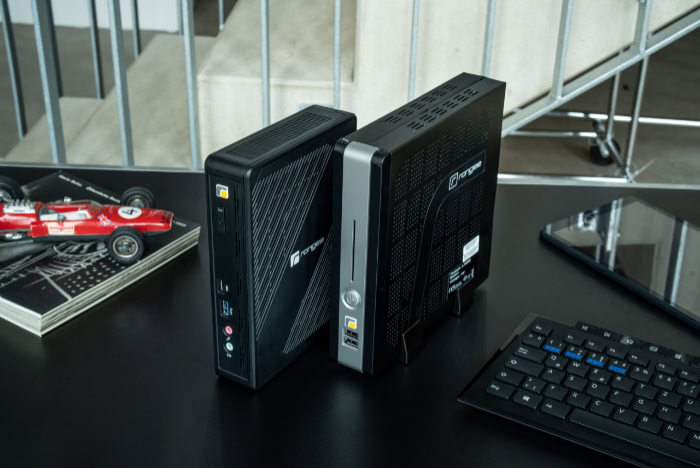What Is a Thin Client? Explained

The familiar desktop PC, with its local processing power and storage, is not the only option for enterprise computing. A leaner alternative, the thin client, operates as a lightweight endpoint that relies completely on centralized servers for its applications, processing, and data storage.
By shifting the computational load from individual devices to a powerful back-end infrastructure, organizations can achieve new levels of efficiency and control.
What a Thin Client Is and How It Works
A thin client is a lightweight, low-power computing device designed to connect to a remote server. It contains minimal local hardware and software, offloading the bulk of its computational workload to a virtual desktop infrastructure (VDI), a cloud platform, or another server-based system.
In practice, the thin client operates as an input and output terminal. It captures user interactions and transmits them to the server, which processes the information and runs the applications.
The server then sends screen updates back to the thin client, creating the illusion that the user is interacting with a local desktop operating system.
Architectural Components
A complete thin client environment is built from several distinct but interconnected building blocks. The system relies on these components working together to deliver a seamless user session.
- Endpoint Device: This is the physical hardware the user interacts with. It can be a purpose-built thin client from a manufacturer or even a repurposed older PC running a minimal operating system. Its main job is to initiate a connection and handle basic input and output.
- Connection Broker: This software layer acts as a traffic controller. When a user logs in, the connection broker authenticates their credentials and directs their session to an available resource, such as a personal virtual desktop or a shared application server.
- Centralized Compute and Storage: All processing and data storage resides on powerful servers within a data center or a cloud environment. These back-end systems run the operating systems, host the applications, and securely store all user data, performing the heavy lifting that a traditional PC would handle locally.
Connection Protocols and Session Flow
The communication between a thin client and its server is managed by specialized connection protocols. When a user initiates a session, their device establishes a connection through the broker to an assigned server resource.
From that point, a remote display protocol takes over to manage the interactive experience.
Protocols such as Microsoft's Remote Desktop Protocol (RDP), Citrix's Independent Computing Architecture (ICA), or VMware's PC over IP (PCoIP) are designed to efficiently transmit data over a network. They compress and send the user's inputs to the server.
In return, the server sends back only the pixels that have changed on the screen. This continuous exchange of information is what creates a fluid and responsive remote session, allowing a user to interact with applications as if they were running on the local device.
Thin, Thick, and Zero Clients Compared
Endpoint devices come in several forms, each defined by how much processing and storage occurs locally versus on a central server. The choice between a thick, thin, or zero client directly impacts how an organization manages its devices, secures its data, and delivers applications to its users.
Each model offers a different balance of local autonomy, administrative simplicity, and operational cost.
Thin Clients vs. Thick Clients
The most fundamental distinction in endpoint computing is between thin and thick clients. A thick client, also known as a rich client, is a traditional personal computer with its own operating system, local storage, and dedicated processing power.
It can function independently and run software on its own hardware. In contrast, a thin client relies on a server for its processing, applications, and data storage.
This architectural difference leads to different approaches in management, maintenance, and performance.
| Feature | Thick Client (PC) | Thin Client |
| Processing and Storage | Handled locally on the device. | Offloaded to a centralized server. |
| Management | Each device is managed individually, requiring separate OS patches and software updates. | Managed centrally; updates are applied once on the server, benefiting all connected clients. |
| Data Security | Data is stored on the local device, creating a risk of theft or loss if the device is compromised. | Data resides in the data center, reducing the risk of endpoint data breaches. |
| Offline Capability | Can function and run applications without a network connection. | Requires a stable network connection to the server to function. |
Thin Clients vs. Zero Clients
A zero client is an even more streamlined version of a thin client. While a thin client has a minimal, read-only operating system that offers some configuration flexibility, a zero client has virtually no local OS.
Instead, it uses highly optimized firmware with the sole purpose of initializing a connection to a specific remote desktop environment. This minimalist design creates important trade-offs in flexibility and security.
A thin client's local OS allows it to support multiple remote display protocols, connect to different server types, and sometimes include a local web browser. A zero client is typically tied to a single protocol, such as PCoIP or HDX, and its firmware is dedicated to communicating with a specific VDI vendor's ecosystem.
Because they lack a configurable OS, zero clients have an extremely small attack surface, making them exceptionally secure. Their simple firmware also enables them to boot and connect to a session in just a few seconds.
Choosing the Right Client
Selecting the appropriate endpoint requires aligning the device's capabilities with specific business and user needs. The right choice depends on the workload, security requirements, and the desired management model.
- Thick Clients are best suited for power users who require significant local processing power for resource-intensive tasks like graphic design, video editing, or complex software development. They are also necessary for any role that demands reliable offline productivity.
- Thin Clients provide a balanced solution for environments where centralized management and security are priorities, but some device-level flexibility is still valuable. They are effective in call centers, administrative roles, and training labs where consistent user experiences and simplified support are beneficial.
- Zero Clients are the optimal choice for highly standardized environments where security is the highest priority. They excel in sectors like healthcare, finance, and government, where users perform defined tasks and connect to a single, uniform VDI platform.
Benefits and Business Value

Adopting a thin client infrastructure can provide substantial advantages that go beyond simple hardware replacement. By centralizing computing resources, organizations can streamline administrative tasks, strengthen security postures, and enable a more flexible workforce.
The business value emerges from improved operational efficiency, potential cost savings, and the ability to scale IT resources with greater agility.
Centralized Management and Security
Shifting from distributed thick clients to a centralized model fundamentally simplifies IT management. Instead of patching and updating the operating systems and applications on hundreds or thousands of individual PCs, IT teams can apply updates to a single master image on the server.
A change made once is instantly propagated to all users who connect to that image, drastically reducing maintenance hours and ensuring configuration consistency.
This architecture also creates a more secure environment. Thin clients have a minimal local operating system and no local data storage, which significantly reduces the endpoint's attack surface.
Since all applications run and all data resides within the secure data center, the risk associated with a lost or stolen device is minimized; the physical client contains no sensitive information. This consolidation of data provides administrators with greater control over access policies and monitoring, strengthening the overall security of corporate information.
Cost and Operational Efficiency
While the initial investment in server infrastructure can be significant, thin client deployments often lead to a lower total cost of ownership (TCO) over time. Thin client devices consume far less power than traditional PCs, resulting in lower energy costs across the organization.
Their solid-state design with few or no moving parts makes them more durable and less prone to failure, extending their lifespan well beyond that of a typical desktop computer.
Furthermore, this model promotes resourcefulness. Organizations can extend the life of their existing PC hardware by repurposing older desktops as thin clients.
By installing a minimal operating system, these legacy machines can be converted into functional endpoints for a VDI environment, delaying hardware refresh cycles and maximizing the return on previous investments.
Scalability and Workforce Enablement
A thin client infrastructure is inherently scalable, making it easier to support a growing or distributed workforce. Onboarding a new employee is as simple as providing them with a thin client and a network connection.
They can be provisioned with a full desktop environment in minutes, rather than the hours it might take to image and configure a new PC. This agility allows organizations to expand operations or set up new office locations quickly.
This model is particularly well-suited for supporting remote and hybrid work arrangements. It provides a standardized and secure method for employees to access their corporate desktops and applications from any location.
Because the user's desktop environment is identical whether they are in the office or at home, support becomes much simpler. IT teams can troubleshoot issues centrally without needing physical access to the endpoint device, ensuring a consistent and productive experience for all users.
Challenges and Constraints
While a thin client model offers compelling benefits, it also introduces a unique set of challenges and dependencies that must be carefully managed. The architecture's reliance on a centralized infrastructure and a constant network connection creates potential points of failure and performance bottlenecks.
Network and Latency Dependence
The user experience on a thin client is entirely dependent on the quality of the network connection. Since every keystroke, mouse movement, and screen update travels between the endpoint and the server, the network effectively becomes the computer's backbone.
Insufficient bandwidth or high latency, which is the delay in data transmission, can degrade the session's responsiveness. A poor connection will manifest as input lag, choppy video, and slow screen refreshes, creating a frustrating experience for the user.
For this reason, a stable and robust network is a non-negotiable prerequisite for any thin client deployment. Organizations must ensure that both their internal local area networks and the wide area network connections for remote users can handle the constant stream of protocol traffic without interruption or significant delays.
Multimedia, Peripherals, and Application Compatibility
Certain types of workloads can strain a virtualized environment. Although modern remote display protocols have become much more efficient, graphics-intensive applications like high-definition video editing or complex 3D modeling can still present challenges.
Such tasks demand significant bandwidth and server-side processing power, and the user experience may not match the performance of a dedicated thick client with a powerful local graphics card.
Compatibility with peripherals and applications can also be a hurdle. Specialized USB devices, such as industrial scanners or medical dictation microphones, may require specific drivers or configurations to work correctly within a remote session.
Similarly, some legacy or custom-developed software may not be designed to run in a multi-user, virtualized environment. Thorough testing of all essential peripherals and applications is critical before a full-scale rollout.
Server Capacity and Resilience
Centralizing all computing resources on a server creates a single point of failure. If the server infrastructure experiences an outage, every user connected to it will be unable to work.
Unlike a thick client environment where an individual PC failure affects only one user, a server failure can bring business operations to a halt. Consequently, building high-availability and disaster recovery mechanisms into the server architecture is essential.
Proper capacity planning is equally important. The servers must be provisioned with enough CPU, memory, and storage to handle the combined workload of all simultaneous users.
Undersizing the infrastructure will lead to system-wide slowdowns, particularly during peak periods like the beginning of the workday when many users log in at once. Furthermore, the complete lack of offline capability means that if a user loses their network connection, they lose all access to their desktop, applications, and data.
Use Cases and Implementation Essentials

The successful adoption of a thin client architecture depends on applying it to the right environments and carefully planning the deployment. Not every workload is suitable for a server-based model, but for specific scenarios, the benefits of centralized control and simplified management are transformative.
Best-Fit Environments
Thin clients thrive in environments where user tasks are standardized and centralized control is a high priority. These settings capitalize on the architecture's strengths while being less affected by its limitations.
- Education and Training Labs: In schools and computer labs, thin clients provide a uniform and easily manageable desktop experience for every student. IT staff can quickly reset the environment after each class, ensuring a clean and consistent state for the next group. This model also prevents users from installing unauthorized software or altering system configurations.
- Call Centers: The high-density, task-oriented nature of a call center makes it an ideal candidate for thin clients. Agents typically use a limited set of applications, and the ability to rapidly deploy desktops for new hires simplifies operations. Centralized management also allows for swift updates to scripts and software across the entire agent pool.
- Regulated Industries: Sectors like finance and healthcare benefit immensely from the enhanced security of a thin client model. By keeping all sensitive customer or patient data within the data center and off the local endpoint, organizations can more easily comply with data protection regulations like HIPAA or PCI DSS.
Deployment Models
There are several ways to deliver remote desktops and applications to thin clients, each with different resource requirements and levels of user personalization. The choice of model should align with the organization's workloads and overall IT strategy.
- Hosted Shared Desktops: In this model, often built on technologies like Microsoft's Remote Desktop Session Host (RDSH), multiple users connect to and share a single server operating system. It is a very resource-efficient approach, making it cost-effective for environments where all users run the same set of standard applications.
- Virtual Desktop Infrastructure (VDI): A full VDI deployment provides each user with their own dedicated virtual machine running a desktop operating system like Windows 11. This model offers greater personalization and better application compatibility than shared desktops, but it demands significantly more server hardware and storage resources.
- Browser-Based Access: For organizations heavily invested in web-based applications or Software-as-a-Service (SaaS), the endpoint can be simplified even further. In some cases, a thin client equipped only with a secure web browser is sufficient for users to access all their necessary tools, minimizing both local and back-end management overhead.
Readiness Checklist
A smooth transition to a thin client environment requires proactive planning and preparation across several domains. Addressing these items before deployment will help prevent performance problems and security gaps.
- Size Servers and Storage: Conduct a thorough assessment of your user workloads to accurately calculate the required server CPU, memory, and storage resources. Undersizing the back-end infrastructure is a common cause of poor performance.
- Plan for Network Performance: Evaluate your network's capacity to handle the increased traffic. Measure latency to remote sites and ensure sufficient bandwidth is available to provide a responsive user session.
- Enforce Identity and Access Controls: With all data and applications centralized, managing who can access what becomes paramount. Implement strong authentication methods, such as multi-factor authentication, and establish clear, role-based access policies.
- Select Endpoints: Choose the right type of endpoint device for your needs. The decision between purpose-built thin clients, repurposed PCs, or ultra-secure zero clients will depend on your budget, security requirements, and the specific VDI platform you select.
Conclusion
Thin clients represent a fundamental shift from distributed, device-centric computing to a centralized, server-based model. By moving processing and data storage into the data center, organizations can significantly simplify endpoint management, streamline updates, and strengthen security.
This centralized control, however, comes at the cost of local flexibility and creates a heavy dependence on network performance. The decision to adopt this architecture requires careful consideration.
A successful implementation hinges on thoroughly matching the deployment model to specific user workloads, ensuring network infrastructure is robust enough to provide a responsive session, and aligning the solution with the experience your users require.


